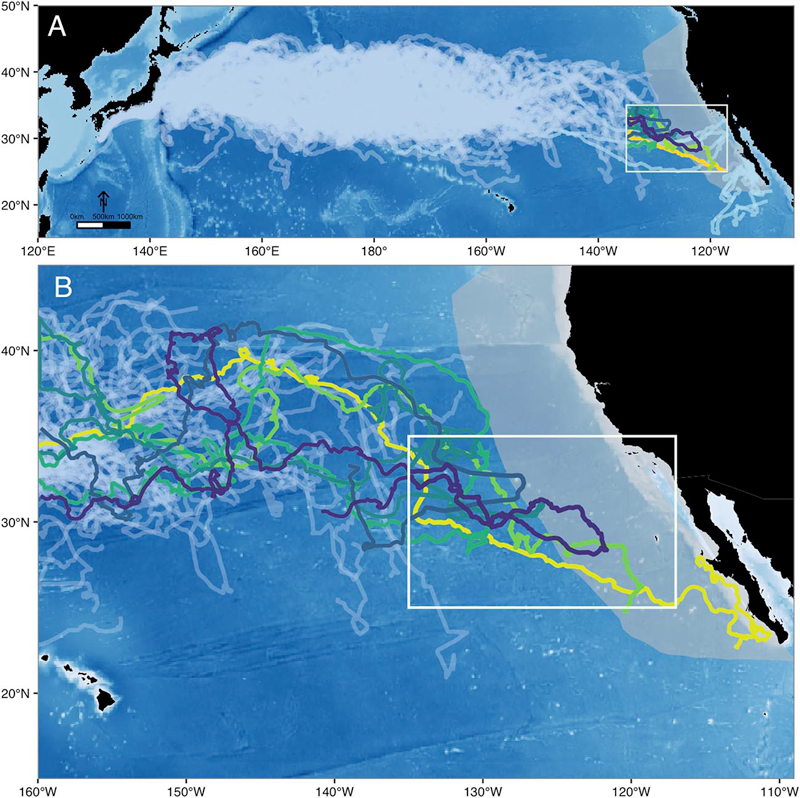In 1996, a turtle named Adelita surprised the world by migrating more than 14,000 kilometers across the Pacific Ocean with a satellite tag attached to her back. She was the first animal to cross an ocean basin while being tracked.
Adelita’s journey was the initial clue that North Pacific loggerhead sea turtles (Caretta caretta), which had been seen in Japan, the central Pacific, and Baja California, all belonged to one distinct population segment. Because of Adelita, scientists know that these loggerheads nest exclusively in Japan but fan out across the North Pacific in search of food during their adolescence.
Now, researchers have new insight into how the turtles spend their “lost years” at sea.
With satellite trackers on 231 loggerheads, scientists discovered how some turtles get past an obstacle known as the Eastern Pacific Barrier. The barrier, which Charles Darwin called “impassible” in 1872, is a stretch of open ocean 6,000 kilometers long that separates the Central and Eastern Pacific Basins. Some species, like coral, are unable to make the jump. But somehow, a tiny subset of turtles regularly travels through the barrier at opportune times to feed off the coast of the Baja California Peninsula.
“We knew that there were turtles off of the North American coast, but for the longest time, we couldn’t figure out exactly how they got there,” said Dana Briscoe, a senior scientist at the Cawthron Institute in Nelson, New Zealand, who completed the research at the Stanford Woods Institute for the Environment.
Sentinels

Scientists in Japan and the United States tagged hundreds of adolescent turtles in Japan between 1997 and 2013. In the ensuing years, the researchers watched as they dispersed across the Pacific Ocean.
Turtles are cold-blooded and prefer ocean temperatures near 18℃, but the waters of the Eastern Pacific Barrier go as low as 9℃ during cold years. The majority (225) of the study’s tagged turtles remained in the warmer central Pacific, but somehow, six sentinel turtles swam through the barrier and wandered all the way to the North American coast. (Coastal waters are prime feeding grounds for loggerheads, as they have more nutritious food (like crabs) than the open ocean (like jellies).)
The sentinel turtles may have migrated through the Eastern Pacific Barrier during years when the ocean was much warmer than usual. According to satellite measurement of the ocean’s surface temperature during warm years, there was a thermal corridor that allowed the turtles to keep swimming in warmer water as they approached Mexico.
“For this particular population, there’s a thermal corridor, or what we also call an ecological bridge, that may open up when the conditions are just right,” Briscoe said. She published the research in the journal Frontiers in Marine Science this year.
The six sentinels weren’t an anomaly. Using an analysis of bone growth layers of 33 turtles from the North American coast previously published by NOAA researcher Cali Turner Tomaszewicz, Briscoe found that turtles were more likely to cross the barrier in warm years. Marine heat waves or other large-scale climate patterns like the El Niño–Southern Oscillation could be at play, she said.
Avoiding Bycatch
Turtles face all kinds of dangers in the ocean: They get snagged as bycatch in fishing, grow tangled in discarded fishing gear or trash, and suffer injuries from ingesting plastic. Although loggerheads are a vulnerable species, most sea turtles are considered endangered. (Even loggerheads are classified as endangered by the U.S. Endangered Species Act.)

“It would be really interesting to see if [the new study] may hold water for other populations of sea turtles because if it does, it could be extremely meaningful for how present and future climate change might alter where new cohorts of sea turtles might forage,” said Lucy Hawkes, an ecologist at the University of Exeter who studies animal migration. Hawkes was not involved in the new research.
In recent years, for instance, loggerheads have shown up in waters where they don’t usually appear. Their appearance forced the closure of the California drift gillnet fishery over 7 months between 2014 and 2016 during an El Niño event.
Conservation groups are paying attention. NOAA released the new resource TurtleWatch that provides maps of loggerhead habitat around the Pacific Islands to help fishing boats avoid bycatch. The unique aspect of TurtleWatch is that the recommendations change on the basis of ocean temperatures.
“What we’re hoping with this corridor paper is that we can start to better understand where they may be going during certain ocean condition events and how we can best manage for that in the future,” Briscoe said.
—Jenessa Duncombe (@jrdscience), Staff Writer
The Link LonkApril 26, 2021 at 08:27PM
https://ift.tt/2Pn2ZWX
What Happens When Six Sea Turtles Go Rogue - Eos
https://ift.tt/2CoSmg4
Sea
/cloudfront-us-east-2.images.arcpublishing.com/reuters/CZF6NULMVVMEXHOP7JK5BSPQUM.jpg)
No comments:
Post a Comment